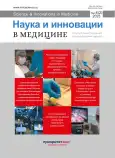The effect of virus-induced cellular transformation on oncogenesis
- Authors: Moskalev A.V.1, Gumilevsky B.Y.1, Zhestkov A.V.2, Zolotov M.O.2
-
Affiliations:
- Military Medical Academy named after S.M. Kirov
- Samara State Medical University
- Issue: Vol 8, No 2 (2023)
- Pages: 108-115
- Section: Infectious diseases
- URL: https://journal-vniispk.ru/2500-1388/article/view/131508
- DOI: https://doi.org/10.35693/2500-1388-2023-8-2-108-115
- ID: 131508
Cite item
Full Text
Abstract
Aim – to summarize the scientific data presented in the recent publications on tumor-associated processes induced by viruses. We analyzed 23 international publications devoted to the development and course of tumor-related processes associated with oncogenic viruses.
The tumor-associated mechanisms are based on the processes of cell transformation, which largely depend on the state of telomeres. No less important are viral and cellular oncogenes, molecular circuits that control cell proliferation. Viral oncogenes encode proteins that increase the concentration of telomerase in the infected cells, and thereby increase the number of cell division cycles. The immune homeostasis, maintaining the integrity of body tissues, is regulated by activating and inhibiting metabolic pathways. The errors in the functioning of these signaling pathways caused by oncogenic viruses can lead to cell transformation and oncogenesis. Guaninenucleotide-binding protein RAS and protein kinase AKT are important components of signaling pathways that contribute to the production of D-type cyclins that control the cell cycle and regulate the activity of metabolic enzymes. Cyclin-dependent kinase is an important factor controlling cell cycles, damage and problems with nucleic acid replication, as well as proper assembly of the mitotic spindle. These processes can be disrupted by the transformation caused by oncogenic viruses. In most cases, viral oncogenes undergo additional changes that contribute to their transformation potential. The transformative activity of viral gene products correlates with binding to specific cellular proteins. In the immunopathogenesis of oncogenesis, an important role belongs to the inactivation of tumor suppressors, and the processes of phosphorylation.
Keywords
Full Text
##article.viewOnOriginalSite##About the authors
Aleksandr V. Moskalev
Military Medical Academy named after S.M. Kirov
Author for correspondence.
Email: alexmav195223@yandex.ru
ORCID iD: 0000-0002-3403-3850
PhD, Professor of the Department of microbiology
Russian Federation, Saint-PetersburgBoris Yu. Gumilevsky
Military Medical Academy named after S.M. Kirov
Email: gumbu@mail.ru
PhD, Professor, Head of the Department of microbiology
Russian Federation, Saint-PetersburgAleksandr V. Zhestkov
Samara State Medical University
Email: avzhestkov2015@yandex.ru
ORCID iD: 0000-0002-3960-830X
PhD, Professor, Head of the Department of general and clinical microbiology, immunology and allergology
Russian Federation, SamaraMaksim O. Zolotov
Samara State Medical University
Email: m.o.zolotov@gmail.com
ORCID iD: 0000-0002-4806-050X
PhD, assistant of the Department of general and clinical microbiology, immunology and allergology
Russian Federation, SamaraReferences
- Griffin DE. The Immune Response in Measles: Virus Control, Clearance and Protective Immunity. Viruses. 2016;10(8):282-291. doi: 10.3390/v8100282
- Li G. Improvement of enzyme activity and soluble expression of an alkaline protease isolated from oil-polluted mud flat metagenome by random mutagenesis. Enzyme Microb Technol. 2017;106:97-105. doi: 10.1016/j.enzmictec.2017.06.015
- Burrell C, Howard C, Murphy F. Fenner and White’s Medical Virology. Academic Press, San Diego, CA, 2016.
- Reizis B. Plasmacytoid Dendritic Cells: Development, Regulation, and Function. Immunity. 2019;50(1):37-50. doi: 10.1016/j.immuni.2018.12.027
- Wacleche VS, Landay A, Routy JP, Ancuta P. The Th17 Lineage: From Barrier Surfaces Homeostasis to Autoimmunity, Cancer, and HIV-1 Pathogenesis. Viruses. 2017;10(9):303-312. doi: 10.3390/v9100303
- Mok YK, Swaminathan K, Zeeshan N. Engineering of serine protease for improved thermostability and catalytic activity using rational design. Int J Biol Macromol. 2019;126:229-237. doi: 10.1016/j.ijbiomac.2018.12.218
- Hadjidj R, Badis A, Mechri S, et al. Purification, biochemical, and molecular characterization of novel protease from Bacillus licheniformis strain K7A. Int J Biol Macromol. 2018;114:1033-1048. doi: 10.1016/j.ijbiomac.2018.03.167
- Thapa RJ, Ingram JP, Ragan KB, et al. DAI Senses Influenza A Virus Genomic RNA and Activates RIPK3-Dependent Cell Death. Cell Host Microbe. 2016;20(5):674-681. doi: 10.1016/j.chom.2016.09.014
- Nash A, Dalziel R, Fitzgerald J. Mims’ Pathogenesis of Infectious Disease. Academic Press, San Diego, CA, 2015.
- Ma Z, Damania B. The cGAS-STING defense pathway and its counteraction by viruses. Cell Host Microbe. 2016;19:150-158. doi: 10.1016/j.chom.2016.01.010
- Takata MA, Gonçalves-Carneiro D, Zang TM, et al. CG dinucleotide suppression enables antiviral defence targeting non-self RNA. Nature. 2017;550(7674):124-127. doi: 10.1038/nature24039
- Katze MG, Korth MJ, Law GL, et al. Viral Pathogenesis: From Basics to Systems Biology. Academic Press, San Diego, CA, 2016.
- Garcia-Sastre A. Ten strategies of interferon evasion by viruses. Cell Host Microbe. 2017;22:176-184. doi: 10.1016/j.it.2014.05.004
- Maillard PV, van der Veen AG, Poirier EZ, et al. Slicing and dicing viruses: antiviral RNA interference in mammals. EMBO J. 2019;38(8):e100941. doi: 10.15252/embj.2018100941
- Behzadi P, García-Perdomo HA, Karpiński TM. Toll-Like Receptors: General Molecular and Structural Biology. Journal of Immunology Research. 2021;2021:9914854. doi: 10.1155/2021/9914854
- Lee S, Liu H, Wilen CB, et al. A secreted viral nonstructural protein deters intestinal norovirus pathogenesis. Cell Host Microbe. 2019:25(6):845-857.e5. doi: 10.1016/j.chom.2019.04.005845-857
- Ahmad L, Mostowy S, Sancho-Shimizu S. Autophagy-Virus Interplay: From Cell Biology to Human Disease. Front Cell Dev Biol. 2018;19:155. doi: 10.3389/fcell.2018.00155
- Ashraf NM, Krishnagopal A, Hussain A, et al. Engineering of serine protease for improved thermo stability and catalytic activity using rational design. Int J Biol Macromol. 2019;126:229-237. doi: 10.1016/j.ijbiomac.2018
- Jeong YJ, Baek SC, Kim H. Cloning and characterization of a novel intracellular serine protease (IspK) from Bacillus megaterium with a potential additive for detergents. Int J Biol Macromol. 2018;108:808-816. doi: 10.1016/j.ijbiomac.2017.10.173
- Diner BA, Lum KK, Javitt A, et al. Interactions of the Antiviral Factor Interferon Gamma-Inducible Protein 16. NIFI16 Mediate Immune Signaling and Herpes Simplex Virus-1 Immunosuppression. Mol Cell Proteomics. 2015;14(9):2341-2356. doi: 10.1074/mcp.M114.047068
- Hemann EA, Green R, Turnbull JB, et al. Interferon-λ modulates dendritic cells to facilitate T cell immunity ion with influenza A virus. Nat Immunol. 2019;20:1035-1045. doi: 10.1038/s41590-019-0408-z
- Zipfel C. Plant pattern-recognition receptors. Trends Immunol. 2014;35(7):345-351. doi: 10.1016/j.it.2014.05.004
- van Gent M, Braem SG, de Jong A, et al. Epstein-Barr virus large tegument protein BPLF1 contributes to innate immune evasion through interference with toll-like receptor signaling. PLoS Pathog. 2014;10(2):e1003960. doi: 10.1371/journal.ppat.1003960
Supplementary files







